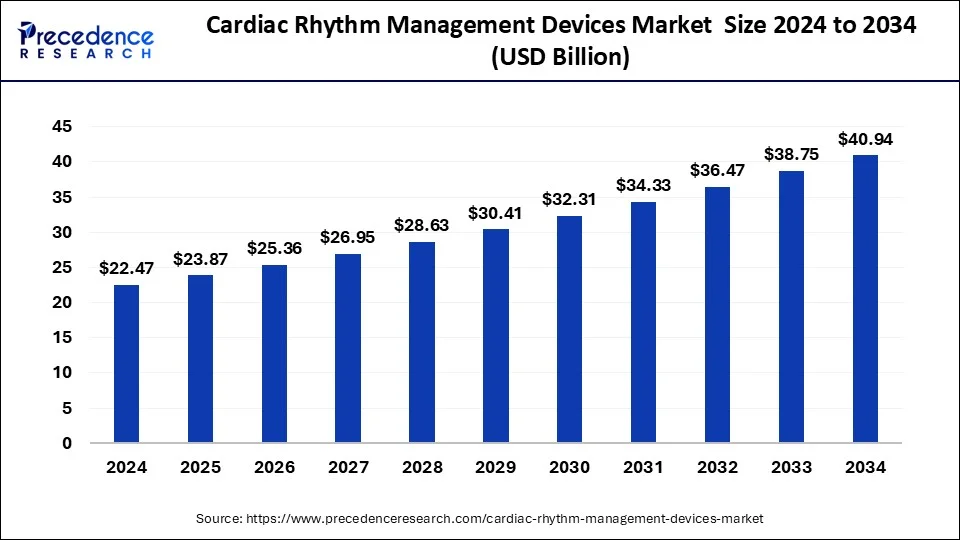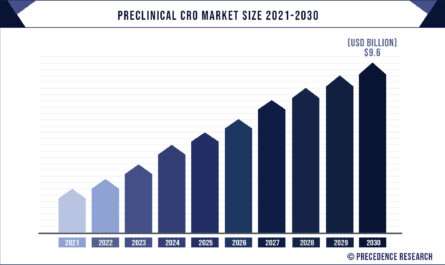The global cardiac rhythm management devices market size surpassed USD 21.15 billion in 2023 and is anticipated to attain around USD 38.75 billion by 2033, poised to grow at a CAGR of 6.24% from 2024 to 2033.
Key Points
- North America has accounted more than 40% of the market share in 2023.
- By product, the defibrillators segment held the largest share of the market in 2023.
- By application, the arrhythmias segment held the largest share of the market in 2023.
- By end-user, the hospitals segment led the market with the largest market share of 50% in 2023.
The cardiac rhythm management devices market encompasses a range of medical devices designed to monitor and regulate the heart’s rhythm, including pacemakers, implantable cardioverter-defibrillators (ICDs), and cardiac resynchronization therapy (CRT) devices. These devices are vital for managing various cardiac arrhythmias and conditions such as bradycardia, tachycardia, and heart failure. The market for cardiac rhythm management devices has witnessed significant growth due to the increasing prevalence of cardiovascular diseases, advancements in technology, and rising healthcare expenditure globally.
Get a Sample: https://www.precedenceresearch.com/sample/3968
Growth Factors:
Several factors contribute to the growth of the cardiac rhythm management devices market. Firstly, the rising incidence of cardiovascular diseases, including atrial fibrillation, heart failure, and coronary artery disease, has fueled the demand for cardiac rhythm management devices. As the aging population grows and lifestyle factors such as obesity and sedentary behavior become more prevalent, the burden of cardiovascular diseases continues to increase, driving the need for effective cardiac rhythm management solutions.
Additionally, advancements in device technology have enhanced the performance, reliability, and longevity of cardiac rhythm management devices, leading to better patient outcomes and improved quality of life. Innovations such as leadless pacemakers, subcutaneous ICDs, and wireless remote monitoring systems have made these devices safer, more convenient, and less invasive, driving adoption among patients and healthcare providers.
Moreover, increasing awareness about the benefits of early detection and treatment of cardiac arrhythmias has led to greater screening and diagnosis rates, driving demand for cardiac rhythm management devices. Patient education initiatives, physician training programs, and advocacy efforts have helped raise awareness about the importance of regular cardiac monitoring and timely intervention, leading to earlier detection and management of arrhythmias.
Furthermore, favorable reimbursement policies and healthcare infrastructure development have facilitated patient access to cardiac rhythm management devices, particularly in emerging markets. Government initiatives to improve healthcare access, expand insurance coverage, and enhance medical device regulation have supported market growth by reducing financial barriers and increasing patient affordability.
Region Insights:
The cardiac rhythm management devices market exhibits regional variations in terms of market size, growth dynamics, and regulatory landscape. North America and Europe are among the leading markets for cardiac rhythm management devices, driven by high healthcare expenditure, advanced healthcare infrastructure, and favorable reimbursement policies. The presence of major medical device manufacturers and research institutions in these regions has further stimulated market growth through technological innovation and product development.
In the Asia Pacific region, rapid urbanization, aging populations, and increasing prevalence of cardiovascular diseases have fueled demand for cardiac rhythm management devices. Countries such as China, India, and Japan are witnessing significant market growth due to rising healthcare spending, expanding access to medical services, and growing awareness about cardiovascular health. However, market penetration in some parts of Asia Pacific may be limited by regulatory challenges, pricing pressures, and healthcare disparities.
Latin America and the Middle East & Africa represent emerging markets for cardiac rhythm management devices, characterized by improving healthcare infrastructure, rising disposable incomes, and growing healthcare awareness. However, market growth in these regions may be hindered by economic volatility, political instability, and limited access to advanced medical technologies in some areas.
Cardiac Rhythm Management Devices Market Scope
| Report Coverage | Details |
| Growth Rate from 2024 to 2033 | CAGR of 6.24% |
| Global Market Size in 2023 | USD 21.15 Billion |
| Global Market Size by 2033 | USD 38.75 Billion |
| U.S. Market Size in 2023 | USD 6.35 Billion |
| U.S. Market Size by 2033 | USD 11.36 Billion |
| Base Year | 2023 |
| Forecast Period | 2024 to 2033 |
| Segments Covered | By Product, By Application, and By End-use |
| Regions Covered | North America, Europe, Asia-Pacific, Latin America, and Middle East & Africa |
Cardiac Rhythm Management Devices Market Dynamics
Drivers:
Several drivers are propelling the growth of the cardiac rhythm management devices market. One of the primary drivers is the increasing prevalence of cardiovascular diseases, driven by aging populations, unhealthy lifestyles, and rising prevalence of risk factors such as hypertension, diabetes, and obesity. As the incidence of cardiac arrhythmias and heart failure continues to rise, the demand for effective cardiac rhythm management devices is expected to grow.
Moreover, technological advancements in device design, materials, and software have led to the development of next-generation cardiac rhythm management devices with enhanced features and capabilities. For example, leadless pacemakers offer a less invasive alternative to traditional pacemakers, while advanced algorithms and remote monitoring systems improve device performance and patient management.
Furthermore, the shift towards value-based healthcare and patient-centered care models is driving the adoption of cardiac rhythm management devices that offer improved outcomes, reduced complications, and better patient experiences. Device manufacturers are increasingly focusing on developing innovative solutions that prioritize patient safety, comfort, and quality of life, driving market growth through differentiation and competitive advantage.
Additionally, the growing emphasis on preventive healthcare and early intervention strategies is driving demand for cardiac rhythm management devices for remote monitoring, ambulatory care, and home-based therapy. Telemedicine platforms, mobile health applications, and wearable devices enable patients to monitor their cardiac health and communicate with healthcare providers, facilitating timely intervention and personalized treatment plans.
Opportunities:
The cardiac rhythm management devices market presents several opportunities for growth and innovation. Firstly, there is significant potential for market expansion in emerging markets, where rising healthcare spending, expanding access to medical services, and increasing disease awareness are driving demand for cardiac rhythm management devices. Device manufacturers can capitalize on these opportunities by expanding their presence in emerging markets, tailoring products to local needs, and forging strategic partnerships with healthcare providers and distributors.
Moreover, advancements in digital health technologies, artificial intelligence, and data analytics present opportunities for the development of smarter, more connected cardiac rhythm management devices. Remote monitoring systems, predictive analytics algorithms, and personalized treatment algorithms can help improve patient outcomes, reduce healthcare costs, and enhance patient engagement.
Furthermore, there is growing interest in the integration of cardiac rhythm management devices with other medical technologies and healthcare systems to create more holistic and efficient patient care pathways. For example, integrating pacemakers with implantable sensors, remote monitoring platforms, and electronic health records can enable real-time data collection, continuous monitoring, and proactive management of cardiac arrhythmias, leading to better outcomes and lower healthcare utilization.
Additionally, there is a need for greater focus on addressing unmet clinical needs and improving outcomes for specific patient populations, such as pediatric patients, elderly patients, and patients with complex comorbidities. Tailoring device designs, treatment protocols, and patient support services to meet the unique needs of these populations can create opportunities for market differentiation and growth.
Challenges:
Despite the significant growth prospects, the cardiac rhythm management devices market faces several challenges that must be addressed to realize its full potential. One of the primary challenges is the increasing regulatory scrutiny and compliance requirements imposed by regulatory authorities worldwide. Stringent regulatory requirements for device approval, clinical trials, and post-market surveillance can prolong the time to market and increase development costs for manufacturers, posing barriers to entry for smaller companies and stifling innovation.
Moreover, reimbursement challenges, pricing pressures, and healthcare budget constraints can impact market access and affordability for patients and healthcare providers. Reimbursement policies vary by country and region, leading to disparities in patient access to advanced cardiac rhythm management devices and therapies. Pricing pressures from healthcare payers, group purchasing organizations, and competitive market dynamics can further strain profit margins for device manufacturers, limiting investment in research and development and innovation.
Furthermore, concerns about patient safety, device reliability, and long-term performance remain significant barriers to adoption for some cardiac rhythm management devices. Issues such as device recalls, adverse events, and implant complications can erode patient confidence and trust in device manufacturers and healthcare providers, leading to reluctance to undergo device implantation or follow-up care.
Additionally, the complexity and variability of cardiac arrhythmias present challenges for accurate diagnosis, appropriate treatment selection, and optimal device programming. Cardiac rhythm management devices must be tailored to individual patient characteristics, disease severity, and clinical presentation to maximize efficacy and minimize risks. However, achieving optimal device programming and patient management can be challenging due to the lack of standardized protocols, limited clinical evidence, and variability in physician expertise and practice patterns.
Read Also: Ammonium Chloride Market Size To Cross USD 2.24 Bn by 2033
Recent Developments
- In June 2023, Philips and BIOTRONIK formed a strategic alliance to expand care for out-of-hospital cardiology labs.
- In October 2023, MicroPort CRM launched the ULYS ICD and INVICTA Defibrillation Lead in Japan.
- In October 2023, Boston Scientific introduced the LUX-Dx II+ Insertable Cardiac Monitor System.
Cardiac Rhythm Management Devices Market Companies
- Physio-Control, Inc. (Stryker)
- BIOTRONIK
- Schiller
- Medtronic
- Abbott
- Koninklijke Philips N.V.
- Zoll Medical Corporation
- Schiller
- Boston Scientific Corporation
- Progetti Srl
- LivaNova Plc
Segments Covered in the Report
By Product
- Pacemakers
- Implantable
- External
- Defibrillators
- Implantable Cardioverter Defibrillators (ICD)
- S-ICD
- T-ICD
- Implantable Cardioverter Defibrillators (ICD)
- External Defibrillator
- Manual External Defibrillator
- Automatic External Defibrillator
- Wearable Cardioverter Defibrillator
- Cardiac Resynchronization Therapy (CRT)
- CRT-Defibrillator
- CRT-Pacemakers
By Application
- Congestive Heart Failure
- Arrhythmias
- Bradycardia
- Tachycardia
- Others
By End-use
- Hospitals
- Cardiac care centers
- Ambulatory surgical centers
- Others
By Geography
- North America
- Europe
- Asia-Pacific
- Latin America
- Middle East and Africa
Contact Us:
Mr. Alex
Sales Manager
Call: +1 9197 992 333
Email: sales@precedenceresearch.com
Web: https://www.precedenceresearch.com
Blog: https://www.expresswebwire.com/
Blog: https://www.uswebwire.com/


